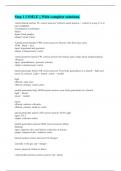Step 1 USMLE || With complete solutions.
ventral lateral nucleus VL correct answers Ventral Lateral nucleus = ventral is at top, C is at top of alphabet Coordination Cerebellum
Motor Input: basal ganglia Output: motor cortex
Ventral posteromedial VPM correct answers Sensory info from face, taste VPM : Mask = face
input: trigeminal and gustatory
output: somatosensory cortex
ventral posterior lateral VPL correct answers all sensory pain, temp, touch, proprioception, vibration
input: spinothalamic, posterior column, output: somatosensory cortex
lateral geniculate body LGB correct answers Your body geniculates in a church = light and music in a church. Light = lateral , music = medial light
afferent: optic tract
efferent: primary visual cortex
medial geniculate body MGB correct answers your body geniculates in a church
light = lateral
music = medial music
afferent: inferior colliculus efferent: primary auditory cortex
lateral geniculate nuclei LGN correct answers LGN Light input: CN 2 output: calcarine sulcus
medial geniculate nucleus MGN correct answers Music Hearing: input: superior olive and inferior colliculus of tectum
output: temporal lobe - auditory cortex
lateral nucleus correct answers Fxn: Hunger Laterally is the gas cap = hunger
lesion: anorexia, failure to thrive
ventromedial nucleus correct answers fxn: satiety lesion: hyperphagia, obesity
supraoptic nuclei correct answers paraventricular/supraoptic nuclei lacrimal glands are above eyes = supra - optic. Lacrimal glands make you cry = water production
produce ADH and oxytocin regulate water balance
lesion: central diabetes insipidus (polyuria, polydipsia)
anterior nucleus correct answers Anterior (A/C)
cooling
Parasympathetic lesion: hyperthermia
posterior nucleus correct answers posterior releases heat (hot fart) fxn: warms you up
lesion: inability to thermoregulate
arcuate nucleus correct answers arc
curved or arched udder : produces hypothalamic releasing factors AND dopamine which inhibits prolactin and milk secretion
preoptic nuclei correct answers before your eyes , in front of your eyes. someone needs to be attractive to stimulate that GnRH Release lesion: Kallman syndrome ( no GnRH due to defective migration of GnRH releasing neurons from the olfactory bulb to the preoptic nuclei > decreased GnRH secretion and underdeveloped olfactory bulbs (anosmia)
mammillary bodies correct answers memory contains hemorrhagic lesions in Wernicke Korsakoff syndrome
vitamin A (retinol) correct answers active forms: retinal, retinoic acid (all trans retinoic acid is a vitamin A derivative used to treat Acute Myelogenous Leukemia t(15: 17 translocation). This drug forces differentiation of the neoplastic cells, halting proliferation. Retinol (vit A nurtures the retinA, acts as an Antioxidant, and can be used for Acne treatment)
Vitamin A can be used to treat Measles
sources: liver, egg yolks, kidney, leafy veggies functions: vision (retinal pigments)
antioxidant
gene transcription
promotes cell differentiation and specialization
Deficiency: night blindness
xerosis cutis
squamous cell metaplasia e.g. Bitot spots
keratomalacia
immunosuppression
toxicity:
acute toxicity: N/V, blurred vision, dizziness
chronic toxicity: teratogenicity**, alopecia, arthralgias, hepatic toxicity, hepatomegaly, pseduotumor cerebri (Idiopathic intracranial HTN: chronically elevated intracranial HTN w/o
evidence of hydrocephalus or a space occupying lesion. Clinical features: Headaches, visual disturbances (diplopia, vision loss_ and pulsatile tinnitus. Primarily affects obese F between 15-45 yrs old (OCPs are risk factor)
**isotretinion is highly teratogenic. A (-) pregnancy test and 2 forms of contraception are required for prescribing isoretinion to women
Teratogenic effects: Sound a lot like DiGeorge syndrome
- facial anomalies (cleft palate)
- thymic agenesis - cardiovascular anomalies
- neurodevelopmental disability
- fetal death
vitamin D (calciferol) correct answers active forms: 1,25 dihydroxyvit D (calcitriol)
storage form: 25 hydroxyvitamin D (calcidoil)
sources: - cholecalciferol (provitamin D3): exposure to sunlight, fish, milk, plants
- ergocalciferol (provitamin D2): plants, fungi, yeast, fortified foods (milk, cereals, formula
fxn: calcium and Phosphate homeostasis increases absorption of Ca and P in intestine increases bone resorption at HIGH levels. increases bone mineralization at LOW levels. Aka at high levels vit D activates osteoclasts > calcium release from bone. at low levels vit D activates osteoblasts > builds bone
deficiency: hypocalcemic tetany, osteomalacia in adults, rickets in children
toxicity: hypercalcemia, hypercalciuria, stupor, loss of appetite Vit D therapy: - prevention and treatment for osteoporosis - Paget disease ( increased bone turnover. causes normal lamellar bone to be replaced by weak, woven bone - genetic) - Prenatal supplementation for vegetarian mothers (vitamin D)
hypocalcemia correct answers prolonged QT
neuromuscular toxicity: tetany, carpopedal spasm, perioral parasthesia decreased calcium = increased QT
calcitriol correct answers enhances mineralization , increased Ca, P absorption from gut, kidneys. Increases serum calcium and Phosphate levels
PTH correct answers produced from parathyroid glands third pharyngeal pouch dorsal wings: inferior parathyroid glands
ventral wings: thymus fourth pharyngeal pouch
dorsal wings: superior parathyroid glands
ventral wings: ultimobranchial body, parafollicular C cells of the thyroid PTH increases serum calcium and decreases serum Phosphate. PTH acts on kidneys to increase calcium reabsorbtion. Does not reabsorb Phosphate. PTH acts on bone to cause increased calcium and P release (bone resorption)
DiGeorge Syndrome correct answers Maldevelopment of 3 and 4 pharyngeal pouches, fascial
dysmorphia, cardiac shunt, lack of T-cells, undeveloped paracortex
22q11 deletion
calcitonin correct answers acts on bone to cause decreased bone resorption (decreased Calcium and phosphate release)
decreases calcium and P absorption from GI tract and kidneys net effect: decreases serum calcium and serum P
hypercalcemia correct answers cause: increased PTH, granulomatous disorders (sarcoidosis), thiazide diuretic use, and bone remodeling/demineralization
hypercalcemia : causes nephrolithiasis, bone pain, constipation, neuropsychiatric symptoms (anxiety), cardiac arrhythmias (shortens QT), and muscle weakness increased calcium = decreased QT
vitamin E (tocopherol) correct answers tocopherol, tocotrienol
sources: meat, eggs, oils, leafy veggies




